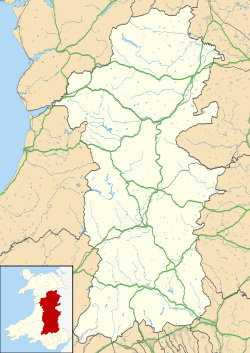Whetstones (stone circle)
| Location | Corndon Hill |
|---|---|
| Coordinates | 52°34′16″N 3°01′41″W / 52.57108°N 3.02803°W |
| Type | Stone circle |
| History | |
| Periods | Neolithic / Bronze Age |
The Whetstones are, or were, a stone circle beneath Corndon Hill in the parish of Church Stoke, Montgomeryshire, Wales, near the border with Shropshire, England. They lie immediately to the west of the village of White Grit and close to Priestweston.[1] The site is also a short distance from the better-known Hoarstones and Mitchell's Fold circles.
The circle was largely destroyed in the 19th century, and only a few fragments now remain.[1] An 1841 account described them as even then fragmentary, but comprising three main stones, then "leaning, owing to the soft and boggy nature of the soil. They stand equidistant and assume a circular position [...] The highest of these is four feet above the surface; one foot six inches in thickness, and three feet in width."[2] In 1860, the antiquarian Robert William Eyton still referred to the Whetstones as a "remarkable monument",[3] but they were later stated to have been dug up, and the stones incorporated into a boundary wall, in about 1870.[4] Aubrey Burl notes that "nearly all of its stones were blown up in the 1860s [...] when the last stone was uprooted around 1870 charcoal and bones were seen".[5]
The remnants of the circle can still be observed from an adjacent field boundary, or from the northern summit of Corndon Hill.[1] Large stones are also visible now forming a boundary next to a footpath, which were probably also once incorporated in the circle.[1]
References
- ^ a b c d The Whetstones, Megalithic Portal
- ^ Hartshorne, C. H. Salopia Antiqua, London: J W Parker, 1841, p.33
- ^ Eyton, R. W. Antiquities of Shropshire, Volumes 11-12, J.R. Smith, 1860, p.159
- ^ "The History of Chirbury" in Transactions of the Shropshire Archaeological and Natural History Society, 1906, 231
- ^ Burl, A. A guide to the stone circles of Britain, Ireland and Brittany, Yale University Press, 2005, p.175

